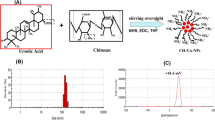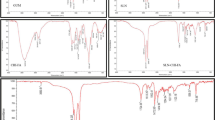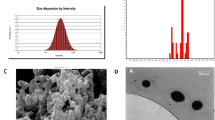Abstract
Purpose
Bevacizumab (BCZ) is a recombinant monoclonal antibody that inhibits the biological activity of the vascular endothelial growth factor, which has an important role in angiogenesis for tumoral growth and progression. In this way, our objective was to develop chitosan-coated lipid-core nanocapsules functionalized with BCZ by an organometallic complex using gold-III.
Methods
The formulation was produced and characterized in relation to physicochemical characteristics. Furthermore, the antitumoral and antiangiogenic activities were evaluated against C6 glioma cell line and chicken embryo chorioallantoic membrane (CAM), respectively.
Results
Final formulation showed nanometric size, narrow polydispersity, positive zeta potential and gold clusters size lower than 2 nm. BCZ in aqueous solution (0.01–0.10 μmol L−1) did not show cytotoxic activity in vitro against C6 glioma cell line; although, MLNC-Au-BCZ showed cytotoxicity with a median inhibition concentration of 30 nmol L−1 of BCZ. Moreover, MLNC-Au-BCZ demonstrated cellular internalization dependent on incubation time and BCZ concentration. BCZ solution did not induce significant apoptosis as compared to MLNC-Au-BCZ within 24 h of treatment. CAM assay evidenced potent antiangiogenic activity for MLNC-Au-BCZ, representing a decrease of 5.6 times in BCZ dose comparing to BCZ solution.
Conclusion
MLNC-Au-BCZ is a promising product for the treatment of solid tumors.








Similar content being viewed by others
Abbreviations
- BCZ:
-
Bevacizumab
- CAM:
-
Chorioallantoic membrane
- CCT:
-
Caprylic/capric triglyceride
- DLS:
-
Dynamic light scattering
- NTA:
-
Nanoparticle tracking analysis
- DMEM:
-
Dulbecco’s Modified Eagle’s Medium
- FTIR:
-
Fourier transform infrared spectroscopy
- LNC:
-
Lipid-core nanocapsules
- LNC-Au:
-
Lipid-core nanocapsules functionalized with gold-III
- LNC-Au-Phe:
-
Lipid-core nanocapsules functionalized with gold-III and phenylalanine
- MLNC:
-
Chitosan-coated lipid-core nanocapsules
- MLNC-Au:
-
Chitosan-coated lipid-core nanocapsules functionalized with gold-III
- MLNC-Au-BCZ:
-
Chitosan-coated lipid-core nanocapsules functionalized with gold-III and bevacizumab
- MLNC-Au-Phe:
-
Chitosan-coated lipid-core nanocapsules functionalized with gold-III and phenylalanine
- MLNCf-Au-BCZ:
-
Fluorescent chitosan-coated lipid-core nanocapsules functionalized with gold-III and bevacizumab
- P80:
-
Polysorbate 80
- PCL:
-
Poly(ε-caprolactone)
- PDI:
-
Polydispersity index
- SL:
-
Soybean lecithin
- SM:
-
Sorbitan monostearate
- TEM:
-
Transmission electron microscopy
- VEGF:
-
Vascular endothelial growth factor
References
Fiel LA, Rebêlo LM, Santiago TM, Adorne MD, Guterres SS, Sousa JS, et al. Diverse deformation properties of polymeric nanocapsules and lipid-core nanocapsules. Soft Matter. 2011;7:7240–7.
Bender EA, Adorne MD, Colomé LM, Abdalla DSP, Guterres SS, Pohlmann AR. Hemocompatibility of poly(ɛ-caprolactone) lipid-core nanocapsules stabilized with polysorbate 80-lecithin and uncoated or coated with chitosan. Int J Pharm. 2012;426(1–2):271–9.
Bender EA, Cavalcante MF, Adorne MDA, Colomé LM, Guterres SS, Abdalla DSP, Pohlmann A.R. New strategy to surface functionalization of polymeric nanoparticles: one-pot synthesis of scFv anti-LDL(−)-functionalized nanocapsules. Pharm Res 2014;31(11):2975–2298.
Mayer FQ, Adorne MD, Bender EA, Carvalho TG, Dilda AC, Beck RCR, et al. Laronidase-functionalized multiple-wall lipid-core nanocapsules: promising formulation for a more effective treatment of mucopolysaccharidosis type I. Pharm Res. 2014;32(3):941–54.
Oliveira CP, Prado WA, Lavayen V, Büttenbender SL, Beckenkamp A, Martins BM, et al. Bromelain-functionalized multiple-wall lipid-core nanocapsules: formulation, chemical structure and antiproliferative effect against human breast cancer cells (MCF-7). Pharm Res. 2017;34(2):438–52.
Antonow MB, Franco C, Prado W, Beckenkamp A, Silveira GP, Buffon A, et al. Arginylglycylaspartic acid-surface-functionalized doxorubicin-loaded lipid-core nanocapsules as a strategy to target alpha(v) beta(3) integrin expressed on tumor cells. Nanomaterials (Basel). 2018;8(1):2.
Pérez-Herrero E, Fernández-Medarde A. Advanced targeted therapies in cancer: drug nanocarriers, the future of chemotherapy. Eur J Pharm Biopharm. 2015;93:52–79.
Bagri A, Kouros-Mehr H, Leong KG, Plowman GD. Use of anti-VEGF adjuvant therapy in cancer: challenges and rational. Trends Mol Med. 2010;16(3):122–32.
Falcon BL, Chintharlapalli S, Uhlik MT, Pytowski B. Antagonist antibodies to vascular endothelial growth factor receptor 2 (VEGFR-2) as anti-angiogenic agents. Pharmacol Ther. 2016;164:204–25.
Danhier F, Feron O, Préat V. To exploit the tumor microenvironment: passive and active tumor targeting of nanocarriers for anti-cancer drug delivery. J Control Release. 2010;148(2):135–46.
Barreto JA, O’Malley W, Kubeil M, Graham B, Stephan H, Spiccia L. Nanomaterials: applications in cancer imaging and therapy. Adv Mater. 2011;23(12):H18–40.
Brastianos PK, Batchelor TT. Vascular endothelial growth factor inhibitors in malignant gliomas. Target Oncol. 2010;5(3):167–74.
Balyasnikova IV, Ferguson SD, Sengupta S, Han Y, Lesniak MS. Mesenchymal stem cells modified with a single-chain antibody against EGFRvIII successfully inhibit the growth of human xenograft malignant glioma. PLoS One. 2010;5(3):e9750.
Hurwitz H, Fehrenbacher L, Novotny W, Cartwright T, Hainsworth J, Heim W, et al. Bevacizumab plus irinotecan, fluorouracil, and leucovorin for metastatic colorectal cancer. N Engl J Med. 2004;350(23):2335–42.
Cohen MH, Gootenberg J, Keegan P, Pazdur R. FDA drug approval summary: bevacizumab (Avastin) plus carboplatin and paclitaxel as first-line treatment of advanced/metastatic recurrent nonsquamous non-small cell lung cancer. Oncologist. 2007;12(6):713–8.
Miller K, Wang M, Gralow J, Dickler M, Cobleigh M, Perez EA, et al. Paclitaxel plus bevacizumab versus paclitaxel alone for metastatic breast cancer. N Engl J Med. 2007;357(26):2666–76.
Summers J, Cohen MH, Keegan P, Pazdur R. FDA drug approval summary: bevacizumab plus interferon for advanced renal cell carcinoma. Oncologist. 2010;15(1):104–11.
Cohen MH, Shen YL, Keegan P, Pazdur R. FDA drug approval summary: bevacizumab (Avastin) as treatment of recurrent glioblastoma multiforme. Oncologist. 2009;14(11):1131–8.
Lim ZZJ, Li J-EJ, Ng C-T, Yung L-YL, Bay B-H. Gold nanoparticles in cancer therapy. Acta Pharmacol Sin. 2011;32(8):983–90.
Kumar A, Ma H, Zhang X, Huang K, Jin S, Liu J, et al. Gold nanoparticles functionalized with therapeutic and targeted peptides for cancer treatment. Biomaterials. 2012;33(4):1180–9.
Shukla R, Bansal V, Chaudhary M, Basu A, Bhonde RR, Sastry M. Biocompatibility of gold nanoparticles and their endocytotic fate inside the cellular compartment: a microscopic overview. Langmuir. 2005;21(23):10644–54.
Patra CR, Bhattacharya R, Mukhopadhyay D, Mukherjee P. Fabrication of gold nanoparticles for targeted therapy in pancreatic cancer. Adv Drug Deliv Rev. 2010;62(3):346–61.
Liang H, Tian H, Deng M, Chen X. Gold nanoparticles for cancer theranostics. Chin J Chem. 2015;33:1001–10.
Rajeshkumar S. Anticancer activity of eco-friendly gold nanoparticles against lung and liver cancer cells. J. Genet. Eng. Biotechnol. 2016;14(1):195–202.
Pavlovich E, Volkova N, Yakymchuk E, Perepelitsyna O, Sydorenko M, Goltsev A. In vitro study of influence of au nanoparticles on HT29 and SPEV cell lines. Nanoscale Res Lett. 2017;12(1):494.
Poletto FS, Fiel LA, Lopes MV, Schaab G, Gomes AMO, Guterres SS, et al. Fluorescent-labeled poly(ε-caprolactone) lipid-core nanocapsules: synthesis, physicochemical properties and macrophage uptake. J Colloid Sci Biotechnol. 2012;1:89–98.
McKenzie B, Kay G, Matthews KH, Knott RM, Cairns D. The hen's egg chorioallantoic membrane (HET-CAM) test to predict the ophthalmic irritation potential of a cysteamine-containing gel: quantification using Photoshop® and ImageJ. Int J Pharm. 2015;490(1–2):1–8.
Haiss W, Thanh NTK, Aveyard J, Fernig DG. Determination of size and concentration of gold nanoparticles from UV-Vis spectra. Anal Chem. 2007;79(11):4215–21.
Pretzer LA, Nguyen QX, Wong MS. Controlled growth of sub-10 nm gold nanoparticles using carbon monoxide reductant. J Phys Chem C. 2010;114(49):1226–33.
Dimzon IKD, Knepper TP. Degree of deacetylation of chitosan by infrared spectroscopy and partial least squares. Int J Biol Macromol. 2015;72:939–45.
Tsai D-H, Davila-Morris M, Delrio FW, Guha S, Zachariah MR, Hackley VA. Quantitative determination of competitive molecular adsorption on gold nanoparticles using attenuated total reflectance Fourier transform infrared spectroscopy. Langmuir. 2011;27(15):9302–13.
Cé R, Marchi JG, Bergamo VZ, Fuentefria AM, Lavayen V, Guterres SS, et al. Chitosan-coated dapsone-loaded lipid-core nanocapsules: growth inhibition of clinical isolates, multidrug-resistant Staphylococcusaureus and Aspergillus ssp. Colloids Surf A Physicochem Eng Asp. 2016;511:153–61.
Shukla SK, Mishra AK, Arotiba OA, Mamba BB. Chitosan-based nanomaterials: a state-of-the-art review. Int J Biol Macromol. 2013;59:46–58.
Kumari A, Yadav SK, Yadav SC. Biodegradable polymeric nanoparticles based drug delivery systems. Colloids Surf B: Biointerfaces. 2010;75(1):1–18.
Aslan B, Ozpolat B, Sood AK, Lopez-Berestein G. Nanotechnology in cancer therapy. J Drug Target. 2013;21(10):904–13.
Mora-Huertas CE, Fessi H, Elaissari A. Polymer-based nanocapsules for drug delivery. Int J Pharm. 2010;385(1–2):113–42.
Ivanov MR, Bednar HR, Haes AJ. Investigations of the mechanism of gold nanoparticle stability and surface functionalization in capillary electrophoresis. ACS Nano. 2009;3(2):386–94.
Delong RK, Reynolds CM, Malcolm Y, Schaeffer A, Severs T, Wanekaya A. Functionalized gold nanoparticles for the binding, stabilization, and delivery of therapeutic DNA, RNA, and other biological macromolecules. Nanotechnol Sci Appl. 2010;3:53–63.
Zarabi MF, Arshadi N, Farhangi A, Akbarzadeh A. Preparation and characterization of gold nanoparticles with amino acids, examination of their stability. Indian J Clin Biochem. 2014;29(3):306–14.
Bulcão RP, Freitas FA, Venturini CG, Dallegrave E, Durgante J, Göethel G, et al. Acute and subchronic toxicity evaluation of poly(ɛ-caprolactone) lipid-core nanocapsules in rats. Toxicol Sci. 2013;132(1):162–76.
Stepanenko AA, Dmitrenko VV. Pitfalls of the MTT assay: direct and off-target effects of inhibitors can result in over/underestimation of cell viability. Gene. 2015;574(2):193–203.
Fiel LA, Contri RV, Bica JF, Figueiró F, Battastini AMO, Guterres SS, et al. Labeling the oily core of nanocapsules and lipid-core nanocapsules with a triglyceride conjugated to a fluorescent dye as a strategy to particle tracking in biological studies. Nanoscale Res Lett. 2014;9(1):233.
Antonow MB, Asbahr ACC, Raddatz P, Beckenkamp A, Buffon A, Guterres SS, et al. Liquid formulation containing doxorubicin-loaded lipid-core nanocapsules: cytotoxicity in human breast cancer cell line and in vitro uptake mechanism. Mater Sci Eng C. 2017;76:374–82.
Drewes CC, Alves AC, Hebeda CB, Copetti I, Sandri S, Uchiyama MK, et al. Role of poly(ε-caprolactone) lipid-core nanocapsules on melanoma-neutrophil crosstalk. Int J Nanomedicine. 2017;12:7153–63.
Färkkilã A, Pihlajoki M, Tauriala H, Bützow R, Leminen A, Unkila-Kallio L, et al. Serum vascular endothelial growth factor a (VEGF) is elevated in patients with ovarian granulosa cell tumor (GCT), and VEGF inhibition by bevacizumab induces apoptosis in GCT in vitro. J Clin Endocrinol Metab. 2011;96(12):E1973–81.
Wang L-L, Hu R-C, Dai A-G, Tan S-X. Bevacizumab induces A549 cell apoptosis through the mechanism of endoplasmic reticulum stress in vitro. Int J Clin Exp Pathol. 2015;8(5):5291–9.
Paquet P, Pierard GE. Toxic epidermal necrolysis: revisiting the tentative link between early apoptosis and late necrosis (review). Int J Mol Med. 2007;19(1):3–10.
Hughes KJ, Chambers KT, Meares GP, Corbett JA. Nitric oxides mediates a shift from early necrosis to late apoptosis in cytokine-treated β-cells that is associated with irreversible DNA damage. Am J Physiol Endocrinol Metab. 2009;297(5):E1187–96.
Su Z, Yang Z, Xu Y, Chen Y, Yu Q. Apoptosis, autophagy, necroptosis, and cancer metastasis. Mol Cancer. 2015;14:1–14.
Fink SL, Cookson BT. Apoptosis, pyroptosis, and necrosis: mechanistic description of dead and dying eukaryotic cells. Infect Immun. 2005;73(4):1907–16.
Hartung T, Sabbioni E. Alternative in vitro assays in nanomaterial toxicology. Wiley Interdiscip Rev Nanomed Nanobiotechnol. 2011;3(6):545–73.
Chen Z, Zhang L, Yu J, Chen L, Zhou B. Identification of resveratrol derivative 3,3′,4,4′,5,5′-hexamethoxy-trans-stilbene as a novel pro-angiogenic small-molecule compound. Eur J Pharmacol. 2016;791:185–94.
Ferreira NN, Ferreira LMB, Miranda-Gonçalves V, Reis RM, Seraphim TV, Borges JC, et al. Alginate hydrogel improves anti-angiogenic bevacizumab activity in cancer therapy. Eur J Pharm Biopharm. 2017;119:271–82.
Steffens L, Wenger A, Stark GB, Finkenzeller G. In vivo engineering of a human vasculature for bone tissue engineering applications. J Cell Mol Med. 2009;13(9b):3380–6.
Nowak-Sliwinska P, Segura T, Iruela-Arispe ML. The chicken chorioallantoic membrane model in biology, medicine and bioengineering. Angiogenesis. 2014;17(4):779–804.
Huang W, Arai F, Kawahara T. Egg-in-cube: design and fabrication of a novel artificial eggshell with functionalized surface. PLoS One. 2015;10(3):e0118624.
Kucinska M, Murias M, Nowak-Sliwinska P. Beyond mouse cancer models: three-dimensional human-relevant in vitro and non-mammalian in vivo models for photodynamic therapy. Mutat Res. 2017;773:242–62.
Lokman NA, Elder AS, Ricciardelli C, Oehler MK. Chick chorioallantoic membrane (CAM) assay as an in vivo model to study the effect of newly identified molecules on ovarian cancer invasion and metastasis. Int J Mol Sci. 2012;13(8):9959–70.
Liu M, Scanlon CS, Banerjee R, Russo N, Inglehart RC, Willis AL, et al. The histone methyltransferase EZH2 mediates tumor progression on the chick chorioallantoic membrane assay, a novel model of head and neck squamous cell carcinoma. Transl Oncol. 2013;6(3):273–81.
Acknowledgements
The authors thank Professor Maria Palmira Daflon Gremião (Universidade Estadual Paulista em Araraquara, UNESP) for the Avastin® sample; Professor Sergio Luiz Vieira and Thiago Luiz Noetzold (Aviário de Ensino e Pesquisa do Departamento de Zootecnia, Universidade Federal do Rio Grande do Sul, UFRGS) for the eggs supply; and the Brazilian Agencies (CAPES, CNPq and FAPERGS). This study was financed in part by the Coordenação de Aperfeiçoamento de Pessoal de Nível Superior - Brasil (CAPES, finance code 001), Fundação de Amparo à Pesquisa do Estado do Rio Grande do Sul (FAPERGS: 17/2551-0001002-7; PRONEX FAPERGS-CNPq 16/2551-0000467-6) and Conselho Nacional de Desenvolvimento Científico e Tecnológico (Research grant 305301/2014-4 and INCT-Nanofarma grant 465687/2014-8).
Author information
Authors and Affiliations
Corresponding authors
Additional information
Publisher’s Note
Springer Nature remains neutral with regard to jurisdictional claims in published maps and institutional affiliations.
Electronic supplementary material
ESM 1
(DOCX 2871 kb)
Rights and permissions
About this article
Cite this article
de Cristo Soares Alves, A., Lavayen, V., Figueiró, F. et al. Chitosan-Coated Lipid-Core Nanocapsules Functionalized with Gold-III and Bevacizumab Induced In Vitro Cytotoxicity against C6 Cell Line and In Vivo Potent Antiangiogenic Activity. Pharm Res 37, 91 (2020). https://doi.org/10.1007/s11095-020-02804-0
Received:
Accepted:
Published:
DOI: https://doi.org/10.1007/s11095-020-02804-0




